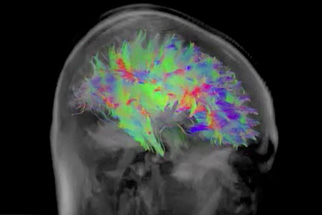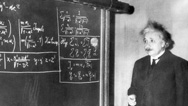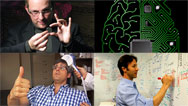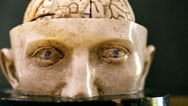There are many ways to look inside the brain without cutting it open, and each imaging technique has its pros and cons. The Laboratory of Neuro Imaging at UCLA has created a human brain atlas using data collected by the International Consortium for Brain Mapping from thousands of people. The goal is to understand the relationship between brain anatomy and function, to see the complex connections between different brain regions, and to be able to tell the difference between normal and abnormal variability. In addition to building a fundamental understanding of the brain, this information can help in planning surgery, developing new medications, or monitoring and treating neurological disorders.
Sources
Abbott, A. 2012. "Mind-controlled robot arms show promise." Nature, 16 May 2012. http://www.nature.com/news/mind-controlled-robot-arms-show-promise-1.10652
Abel, L., et al. 1996. "PET and MRI of the thalamus in never-medicated patients with schizophrenia." American Journal of Psychiatry 153(2): 191-199.
Ahlfors, S. P., et al. 2009. "Early (N170) activation of face-specific cortex by face-like objects." Neuroreport 20(4): 403-407.
Amunts, K., et al. 2003. "Activation of Broca's area during the production of spoken and signed language: a combined cytoarchitectonic mapping and PET analysis." Neuropsychologia 41(14): 1868-1876.
Ashburner, J., et al. 2000. "Navigation-related structural change in the hippocampi of taxi drivers." PNAS 97(8): 4398-4403.
Bartsch, T. 2008. "Hypothalamic deep brain stimulation for cluster headache: experience from a new multicase series." Cephalalgia 28(3): 285-295.
Blank, C., et al. 2001. "Separate neural subsystems within âWernicke's area.'" Brain 124: 83-95.
Boecker, H., et al. 2006. "Hypothalamic Deep Brain Stimulation in Positron." The Journal of Neuroscience 26(13): 3589-3593.
Brass, M., et al. 2008. "Unconscious determinants of free decisions in the human brain." Nature Neuroscience 11: 543-545.
Buckner, R. L., S. E. Peterson, and M. E. Wheeler. 2000. "Memory's Echo: Vivid remembering reactivates sensory-specific cortex." Proceedings of the National Academy of Sciences 97(20): 11125-11129.
Burton, H. 2003. "Visual Cortex Activity in Early and Late Blind People." The Journal of Neuroscience 23(10): 4005-4011.
Carver, F. W., et al. 2010. "Abnormal hippocampal functioning and impaired spatial navigation in depressed individuals: evidence from whole-head magnetoencephalography." American Journal of Psychiatry 167(7): 836-44.
Clark, B. C., et al. 2011. "Age-related changes in motor cortical properties and voluntary activation of skeletal muscle." Current Aging Science 4(3): 192-199.
Cowey, A., et al. 2011. "Enhanced Cortical Excitability in Grapheme-Color Synesthesia and Its Modulation." Current Biology 21(23): 2006-2009.
Deiber, M., et al. 1998. "Neural networks for Braille reading by the blind." Brain 121: 1213-1229.
DeWitt, I. and J. P. Rauschecker. 2012. "Phoneme and word recognition in the auditory ventral stream." Proceedings of the National Academy of Sciences 109(8): 2709-2710.
Fischer, B. 2012. "Distinct âGod Spot' in the Brain Does Not Exist, MU Researcher Says." University of Missouri News Bureau, 18 April 2012. http://munews.missouri.edu/news-releases/2012/0418-distinct-%E2%80%9Cgod-spot%E2%80%9D-in-the-brain-does-not-exist-mu-researcher-says/
Friederici, A. D., et al. 2001. "Musical syntax is processed in Broca's area: an MEG study." Nature Neuroscience 4(5): 540-545.
Hirata, Y., S. Kanda, and S. Kuriki. 2006. "Effects of Musical Experience on Different Components of MEG Responses Elicited by Sequential Piano-Tones and Chords." The Journal of Neuroscience 26(15): 4046-4053.
Knutsen, T., et al. 2005. "Symmetry activates extrastriate visual cortex in human and nonhuman primates." Proceedings of the National Academy of Sciences 102(8): 3159-3163.
Mills, T., et al. 2010. "Exploring frontal lobe function using MEG: A simplified set-shifting task in adults." http://www.frontiersin.org/10.3389/conf.fnins.2010.06.00400/event_abstract
Rauschecker, A. 2004. "A Review of Parietal Lobe Functioning in Planning and Updating Motor Movements." Journal of Young Investigators, September 2004. http://www.jyi.org/volumes/volume11/issue3/articles/rauschecker.html
Credits
- Producer and Writer:
- Lauren S. Aguirre
- Developer:
- Dan Hart
- Designers:
- Tyler Howe, Kim Ducharme, Jessica Sun Lee
- Additional Writing:
- Kate Nussenbaum

Data, images and digital resources provided by the Laboratory of Neuro Imaging at UCLA. Neuroscientific expertise provided by Dr. Ivo D. Dinov, Dr. Shantanu Joshi and Dr. Arthur W. Toga. These graphics utilize processed ICBM and ADNI data.
 Launch Interactive
Launch Interactive








